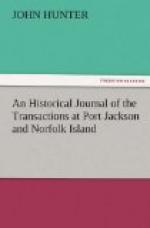Our colonists began to reap the barley on the 22d of November, and the wheat was getting ripe.
The Supply armed tender, after having been under repair from the time she returned from Norfolk-Island, was found, on a survey, to be in so bad a state, that the best repair which could be given her in this country, would only render her serviceable for six months longer; Governor Phillip, therefore, ordered her to England, and she sailed on the 26th of November.
From the debilitated state in which many of the convicts were landed from the last ships, the number of sick were greatly increased; the surgeon’s returns on the 27th, being upwards of four hundred sick at Parramatta; and the same day medicines were distributed to one hundred and ninety-two at Sydney. To the number of sick at Parramatta, upwards of one hundred may be added, who were so weak that they could not be put to any kind of labour, not even to that of pulling grass for thatching the huts. Forty-two convicts died in the month of November, and in these people nature seemed fairly to be worn out; many of them were so thoroughly exhausted that they expired without a groan, and apparently without any kind of pain.
Showers of rain had been more frequent lately than for many months past, but not in the abundance which the ground required; and, from the extreme dryness of the weather, and from the ground not being sufficiently worked before the maize was put into it, a great number of acres were likely to be destroyed. This was one of the many inconveniencies the settlement laboured under, from the want of people to employ in agriculture, who would feel themselves interested in the labour of those that were under their direction, and who had some knowledge as farmers.
The following parcels of land were in cultivation
at
Parramatta, in November, 1791.
Acres./Roods./Perches.
351 2 5 in Maise. 44 1 8 Wheat.
6 1 30 Barley.
1 0 0 Oats.
2 0 3 Potatoes.
4 2 0 Not cultivated, but cleared.
4 2 15 Mostly planted with vines.
6 0 0 The governor’s garden, partly
sown with maize and wheat. 80 0 0 Garden-ground
belonging to individuals. 17 0 0 Land in cultivation
by the New South Wales corps.
150 0 0 Cleared, and to be sowed with turnips.
91 3 2 Ground in cultivation by settlers. 28
0 0 Ground in cultivation by officers of the civil
and military.
134 0 0 Inclosed, and the timber thinned for feeding
cattle.
The above grounds were measured by David Burton, the public gardener, who observes, that the soil in most places is remarkably good, and only wants cultivation to be fit for any use, for the ground that has been the longest in cultivation bears the best crops.




